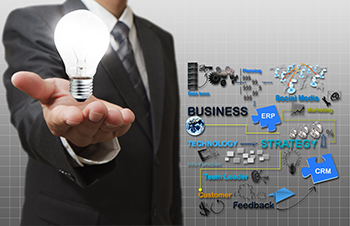 Manufacturing has made great strides in techniques & processes over the last 3 decades. Great advances in ERP (Enterprise Resource Planning) accounting systems have come as well. Often though manufacturing specific applications and accounting systems were developed independently & separate.
Manufacturing has made great strides in techniques & processes over the last 3 decades. Great advances in ERP (Enterprise Resource Planning) accounting systems have come as well. Often though manufacturing specific applications and accounting systems were developed independently & separate.
Disparate and Time Consuming
There might be one system for inventory management, another for payroll and so on. And while these pieces can work at first, as an organization grows, it becomes more obvious this isn’t a long term solution. The system isn't seamless, it takes more time to run reporting and even then, you're not getting the complete picture you need for proper analysis.
This leads to unreliable and inefficient systems—a potential growth disaster for small and medium-sized businesses (SMBs) especially. You could make decisions with wrong conclusions because you didn’t have all the puzzle pieces.
It’s inevitable when this roadblock hits, many organizations understand the need for an ERP solution.
It's crucial for the right ERP solution to contain 2 features:
- Functionality
- Integration
Most organizations focus on functionality, which is of number 1 importance. After all, you need to have a system and process in place to improve your reporting, streamline your budgeting and provide accurate, easily accessible data.
But integration becomes more crucial as your company grows. Without this integration your company growth will be stunted or worse. Yet all too often, it's an afterthought. If installation and integration aren't considered from the start, there can be far-reaching, long-term ERP Implementation problems—both in getting the system online and with substantial budget overspend.
That's not something SMBs, like yours, can afford.
Let’s highlight some ways you can ensure those needs are at the top of the list.
Understand Your Goals
The primary decision to implement & integrate a new ERP system should have the backing of your key stakeholders. It's likely they'll need little convincing. Even so, it's always a good idea to understand the wants and needs of different departments and managers. From there, your organization should be able to tie in the goals of any new ERP solution.
When you have specific outcomes you want to achieve, such as reduced reporting delays or increasing automated & error free data processing, it's much easier to move forward with a clear focus & required leadership support.
Know Your Data
Researching your current data gives you a high probability of completing your integration goals. Answer questions, such as:
- What data is most important to your business?
- What do you need to seamlessly integrate?
- What packages are you already using that work?
- Where does my important data reside?
- Is all of our important data in the same format to make integration feasible?
It might seem obvious, but determining your key data is crucial to making the right choices.
It’s a bonus when you find a platform that works with tools you already use. It makes data integration fast and easy compared to starting from scratch.
Avoid Unnecessary Complexity
Complex systems with bells and whistles might sound amazing. However, the truth is, the more customization, the higher the risk of integration & upgrading problems over the long term. With complexity comes uncertainty, and difficult implementations can require months of outside help. Better to know & utilize that help up front (prevention) than cleaning up afterward trying to find a cure.
A sophisticated, out-of-the-box program that is properly implemented with sufficient user training can make you feel like you haven't missed a beat. And your organization can be more fully integrated in shortened amount of time with the proper planning.
One Last Thought
Choosing the right ERP system is a big decision—one that shouldn't be taken lightly. It's important to keep in mind that the integration process shouldn't get lost in the mix when making decisions. Ultimately, it will have the greatest ROI of your project.
After all, more interconnectedness & integration should be a main reason to upgrade your ERP!
Centage's Maestro Suite Business Intelligence offers seamless, out-of-the-box integration with most popular ERP and accounting systems. Your GL data can automatically be brought into the Maestro BI, allowing you to conduct exceptionally enlightening budgeting, reporting and business intelligence analysis quickly and easily.
To see pre-recorded demos of the Maestro Suite, copy & paste this link http://bit.ly/seibudget or check out our Maestro page on our website: https://www.erpoutsidethebox.com/maestro-suite-by-centage/.
About the Author
For over 25 years Rick Rusch has helped companies utilize technology safely & productively. Recognizing the dangers of the Internet age several years ago, Rick has passionately focused on cybersecurity to help clients guard their reputations & their most precious asset, their digital data. Learn more about me at https://www.secureerpinc.com/about-us/

 Contact Us At
Contact Us At

